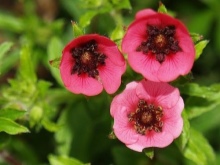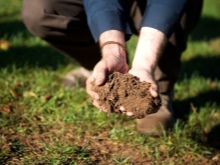Nepalese cinquefoil: description, planting and care

The unpretentious and frost-resistant Nepalese Potentilla is often found in garden plots throughout Russia. The stunning color of the flowers and the compact size of the shrub make it possible to decorate any landscape composition.

Peculiarities
Nepalese cinquefoil is a member of the pink family. In nature, she lives in Nepal and the Western Himalayas, which explains the rather high unpretentiousness of this culture. The plant is a herbaceous perennial. The height of the bush ranges from 30 to 50 centimeters, maximum 60. The straightened and branching stems are painted in bright red. On them are leafy fifteen-centimeter plates, resembling in their shape the paws of an animal or leaves of strawberries.
The shade of the leaves directly depends on the quality of the soil mixture on which the Potentilla lives. Thus, it ranges from light green to deep purple covered with black veins. The flowers are three centimeters in diameter and vary in color from pale pink to a mixture of red and orange. The buds themselves bloom at the top of the shrub from the beginning to the end of the summer season. Each has five petals and grows singly.
One of the advantages of Nepalese Potentilla is its frost resistance, because the plant, as a rule, tolerates winter frosts without any additional protection.



Popular varieties
Since the Nepalese Potentilla has been used in horticulture since the beginning of the 19th century, quite a few hybrid varieties have already been bred. The main differences between individual varieties are not in the grooming process, but in the appearance (color of the buds) and the time when the bush blooms.
Miss Wilmont is considered one of the most popular varieties of Nepalese Potentilla. Beautiful flowers are painted in the deep color of ripe cherry. In the middle of each is a darkened roundness. This variety pleases gardeners with open buds much more and more abundantly than others. It requires serious maintenance and can easily endure winter temperatures.



Variety "Legend" has a darkened center and pink petals, the shade of which becomes darker over time. Just like other representatives of the Nepalese Potentilla, this variety is grown very simply. Fire Flame variety especially appreciated for its unusual color. The center of the open bud is colored a mixture of crimson and red, while the petals have a delicate tone that is a mixture of vanilla and pink. This variety blooms in July and continues to bloom almost until September. The height of the shrub is only 40 centimeters.


Ron Mc Bis variety has a star-like center and coloration reminiscent of Miss Wilmont... In height, the shrub reaches hardly 30 centimeters, and long flowering lasts from May to September. Flowers of the "Flower Carpet" variety painted in exotic coral color. Flowering lasts from the second half of June to mid-September. This variety thrives on any soil, but requires high-quality lighting. Floris variety looks similar but has a bright orange center.
The height of such a shrub reaches 50 centimeters.



How to plant?
It is possible to plant Nepalese Potentilla in open ground during the period from May to September, that is, at any warm season. You can transplant the bush in spring or autumn, when the plant has faded. Planting is best done in a sunny area. It is important not to forget about the need for drainage, especially if the site is characterized by stagnant water. If there is such an opportunity, then you should plant the Nepalese Potentilla next to clematis.
Pits are dug in such a way that a gap of 20-30 centimeters remains between them. In addition, they are necessarily irrigated. The hole should be at least 60 centimeters deep, and the bottom should be covered with a layer of pieces of brick, gravel or sand taken from the river. One second groove is filled with a soil mixture collected from leafy earth, sand and humus, taken in a ratio of 2: 1: 2. The seedling is positioned so that the neck remains above the surface. Everything is covered with earth and must be watered.


How to take care of it properly?
Caring for the Nepalese Potentilla is not particularly laborious. In hot weather, irrigation is required a couple of times a week, and the contents of a ten-liter bucket go to one square meter. If the summer is rainy and cloudy, then the amount of water and the frequency of irrigation should be reduced, focusing on the condition of the soil - for example, irrigate once every two weeks.
It is important to remember that excess moisture disrupts the cultivation of the crop, contributing to decay of the root system... In addition, only heated liquid should be used. Throughout the growing season, it would be good to apply organic fertilizers, as well as ash.
As a rule, this is done immediately after the snow melts, at the time of the appearance of the first buds, and also at the end of flowering.



To save yourself from loosening and weeding procedures, you can use soil mulching using hay, straw or sawdust. The use of mulch is encouraged throughout the season. Shaped pruning is not necessary - it is enough to timely remove dried, diseased or withered parts of Potentilla. If you get rid of the flowers that have completed flowering in a timely manner, then it will be possible to extend the entire period of the presence of the opened buds.
In winter, shelter is required only when the temperature drops to -25 degrees, and during temperature jumps, it rises to zero and even higher. In principle, it will be enough to form a good layer of mulch or use coniferous spruce branches.


Reproduction methods
Nepalese Potentilla is propagated in all common ways. If seeds are selected for this purpose, then they are planted almost at any time. Since sowing in most cases is carried out at home, providing the plant with the necessary amount of light will be a simple task. In principle, experienced gardeners are able to immediately plant seeds in open ground - with proper care, they will germinate quickly. The division of the bush is suitable for the Potentilla that has lived in the same place for at least 4 years.
Either in late spring or early autumn, you need to dig up the bush, and then divide it into several parts using a sharp tool. It is important that each one has at least a small number of roots and kidneys. Additionally, before disembarking, you should use a stimulant. Planting plots is carried out immediately, and the gap between individual plantings ranges from 25 to 40 centimeters.
Quite often, layering is also used for breeding Nepalese Potentilla.


This procedure is carried out either in July or August. The scion used must be healthy and strong, and grow close to the ground. Having made a small incision on it with a processed tool, it is required to tilt the shoot to the ground and sprinkle the wound with soil for reliable fixation.Closer to autumn, the roots should already hatch, and a separate bush is transplanted into fertile soil. However, most gardeners still prefer cuttings.
Planting material can be collected all summer, but you only need to choose last year's and matured shoots. The length of one stalk is 9-10 centimeters. All the lower leaves will have to be torn off, and it is not forbidden to leave a few of the upper ones. The bottom of the cutting is treated with a stimulant, after which it is placed in a loose and light earth. Cuttings can be planted either in separate containers or immediately in the ground of a shaded area. A greenhouse is formed on top of polyethylene or plastic bottles. Regularly moistening the soil and removing the emerging buds, it will be possible to transplant the Nepalese Potentilla to a permanent habitat pretty soon.


Diseases and pests
Nepalese cinquefoil relatively rarely suffers from diseases or exposure to insects. With excessive moisture, the culture becomes infected with common fungal diseases, for example, rust or powdery mildew. In the same cases, the leaves are covered with brown spots. Bordeaux liquid or any suitable fungicide will help to cope with the fungus. Of the insects, scoops most often manifest themselves, which any insecticide can easily deal with. Their presence can be detected by the state of the leaves and buds - the pests feed on them.


Use in landscape design
In the garden, the Nepalese Potentilla will look very beautiful even alone, as the rich color makes the plant a bright accent in any space. A composition of several shrubs of Potentilla of different varieties, which are harmoniously combined with each other, will look interesting and beautiful. In addition, the culture often becomes part of rock gardens or alpine hills.
Several specimens of Potentilla, planted in a row, form original curbs or fences around the perimeter of flower beds or along footpaths.



Wanting to combine cinquefoil with other plants, preference should be given to low-growing perennials of calm color, for example, bells or Veronica. This plant is well combined with cornflowers or lupins.



For information on what kind of Neapali Potentilla is, see the next video.



































































The comment was sent successfully.